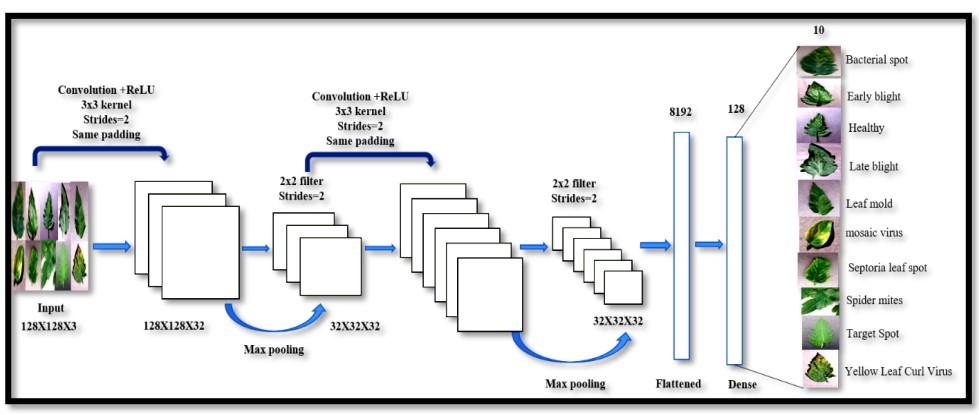Abstract: Deep learning is a cutting-edge image processing method that is still relatively new but produces reliable results. Leaf disease detection and categorization employ a variety of deep learning approaches. Tomatoes are one of the most popular vegetables and can be found in every kitchen in various forms, no matter the cuisine. After potato and sweet potato, it is the third most widely produced crop. The second-largest tomato grower in the world is India. However, many diseases affect the quality and quantity of tomato crops. This article discusses a deep-learning-based strategy for crop disease detection. A Convolutional-Neural-Network-based technique is used for disease detection and classification. Inside the model, two convolutional and two pooling layers are used. The results of the experiments show that the proposed model outperformed pre-trained InceptionV3, ResNet 152, and VGG19. The CNN model achieved 98% training accuracy and 88.17% testing accuracy
Introduction
In the world of agricultural need, the automatic detection of plant diseases using plant leaves is of major importance. Additionally, the early and timely detection of plant diseases improves agricultural production and quality. Farmers in most agricultural countries lose significant amounts of money each year to crop diseases. India is an agrarian nation, with agriculture accounting for a significant portion of the Gross Domestic Product (GDP). Agriculture accounts for 16% of India’s Gross Domestic Product and 10% of total exports. Approximately 75% of India’s population is dependent on agriculture, either directly or indirectly.
Tomatoes are essential due to their high market demand and nutritional value. These antioxidants are very important for our overall health. The production of this famous commodity can be hampered by insects and pests that attack tomato plants and cause various diseases. To treat diseases on tomato plants by hand, farmers need to know about the disease. Farmers face many problems every year when they try to grow healthy crops. Insects and other pests damage the production line and slow it down so that it cannot produce as much as it could. This is a big problem for our economy, and especially for our farmers.

The Convolutional Neural Network (CNN) ResNet101 architecture was adapted to detect anthracnose diseases in olives using hyper spectral images. The collected olives which were free of external effect were inoculated with water and fungus. In order to obtain a dataset with different growth stages of flaws, images were captured on different days. Intending to achieve high accuracy, a data augmentation method was utilized. It increased the low number of captured samples.
Four types of cassava plant diseases, cassava mosaic disease, cassava brown streak, cassava green mite, and cassava bacterial blight, were detected and classified using the Convolutional Neural Network. The dataset had high class imbalance, was poorly contrasted, small in size, had a low resolution and skewed towards specific classes. This kind of dataset will affect the model accuracy. Therefore, to address the abovementioned issues, the authors used existing techniques, which were Contrast Limited Adaptive Histogram Equalization (CLAHE), focal length, class weight, SMOTE (Synthetic Minority Over Sampling Technique), and data augmentation. Then, they proved that after the pre-processing process, the accuracy of the cassava diseases detection model increased.
The CNN ResNet18 architecture was used to predict blackleg disease in potato plants. During image acquisition, LED strips were installed inside an enclosed camera box to avoid variance in the illumination condition. To block ambient light, imaging regions were attached with black rubber strips, and to obtain images in real-world positions, RTK-GNSS receivers were installed in an agriculture vehicle. A resizing process was performed to prevent image distortion. The deficiency in the first week after the emergence of plants taken for the selection of isolated plants should have solved the problem of plant overlap. Data augmentation was not used. Only the transfer learning strategy was applied.

.svg)
